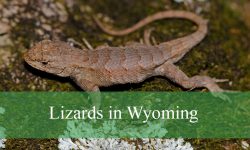Indiana is home to a variety of fascinating birds from the Corvidae family. This guide covers 8 types of crows and magpies in Indiana, including both common residents and rare visitors. These birds are known for their sharp intelligence, loud calls, and striking appearances.
Some species are seen throughout the year in woodlands, farms, and neighborhoods, while others only appear occasionally due to unusual migration patterns or storms. Each type of crow or magpie brings something unique to Indiana’s birdlife.
Exploring the 8 types of crows and magpies in Indiana can help birdwatchers of all levels better understand these clever birds. From the loud caw of the American Crow to the unexpected appearance of the Black-billed Magpie, there’s always something interesting to spot.
Common Crows and Magpies in Indiana
American Crow (Corvus brachyrhynchos)
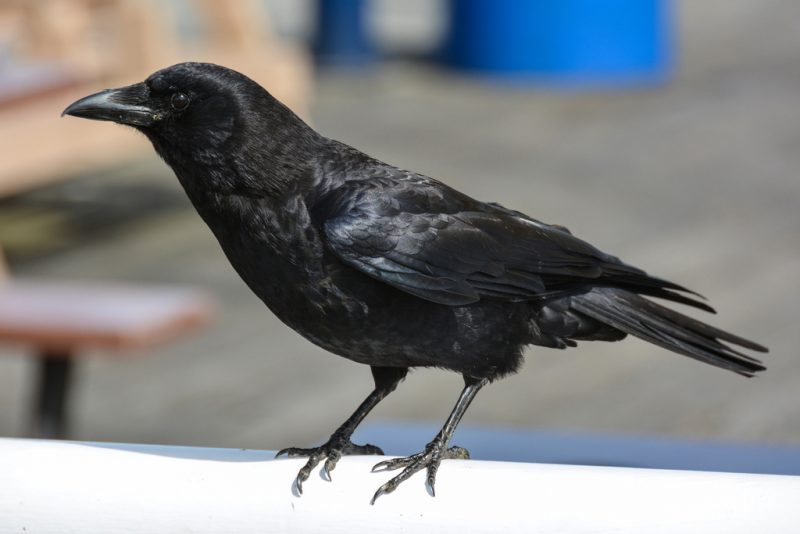
The American Crow is a large, glossy black bird with a thick neck, sturdy legs, and a strong, straight bill. Its plumage is entirely black, but in sunlight, it may shimmer with hints of iridescent purple or green. Measuring about 16 to 21 inches in length with a wingspan of around 33 to 39 inches, this bird is often seen flying with slow, steady wingbeats and a slight glide. Its fan-shaped tail is distinct in flight, helping birders distinguish it from similar species.
In Indiana, American Crows are a common year-round resident, seen in almost every type of habitat, including woodlands, farmland, suburban neighborhoods, and urban parks. Their adaptability makes them one of the most visible and widespread birds in the state. They often form large flocks and can be seen roosting communally in the evenings, especially during colder months. These gatherings can number in the hundreds or even thousands.
Their vocalization is a familiar “caw-caw” that echoes across fields and neighborhoods. It’s loud, harsh, and carries a long distance, often used in alarm or social communication. Crows are highly vocal and intelligent, sometimes mimicking sounds and using different calls to signal food or threats. They also display remarkable problem-solving abilities, including tool use and group coordination when scavenging.
American Crows are opportunistic feeders. They eat insects, small animals, seeds, fruits, carrion, and even human refuse. This dietary flexibility allows them to thrive in a variety of settings, from wild forest edges to city dumpsters. They’re known to cache food for later and are protective of their territories and families, sometimes mobbing larger birds like hawks and owls in defense.
Fish Crow (Corvus ossifragus)
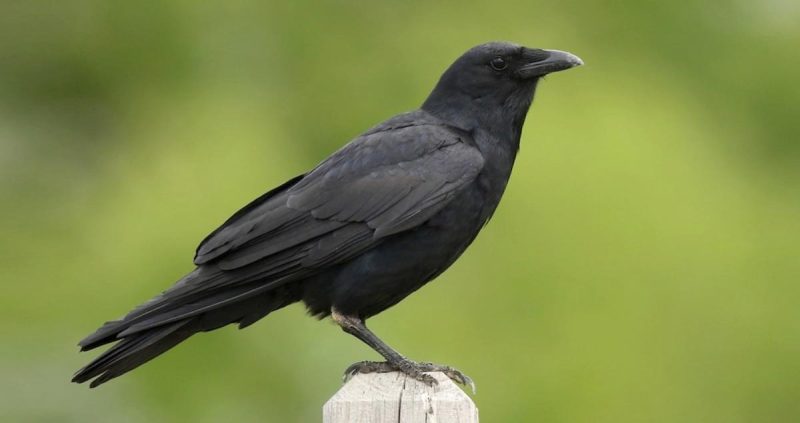
The Fish Crow is a smaller, sleeker relative of the American Crow, measuring about 14 to 16 inches in length with a wingspan of 30 to 34 inches. Its feathers are also entirely black with a glossy sheen, but it is slightly more slender in build. To the eye, Fish Crows and American Crows look almost identical, making voice the most reliable way to tell them apart.
In Indiana, Fish Crows are found mainly in the southern and central regions, especially near waterways such as rivers, swamps, lakes, and wetlands. They are not as widespread as American Crows but are gradually expanding their range northward. Fish Crows are often seen in mixed flocks with American Crows, foraging and roosting together in similar locations.
Their call is a distinguishing feature: a short, nasal “uh-uh” or “ca-ha” that sounds more muffled than the American Crow’s harsh caw. This unique vocalization is often described as sounding like a person with a cold. It is softer, shorter, and more nasal, helping birders identify them even when they are visually indistinct from their cousins.
Diet-wise, Fish Crows are generalist feeders but show a preference for aquatic foods. They consume fish, crabs, amphibians, small animals, grains, and garbage. They are scavengers and often search shorelines for edible material. Their behavior is equally intelligent and social, frequently seen traveling in pairs or small groups and occasionally engaging in playful or curious activities.
Common Raven (Corvus corax)
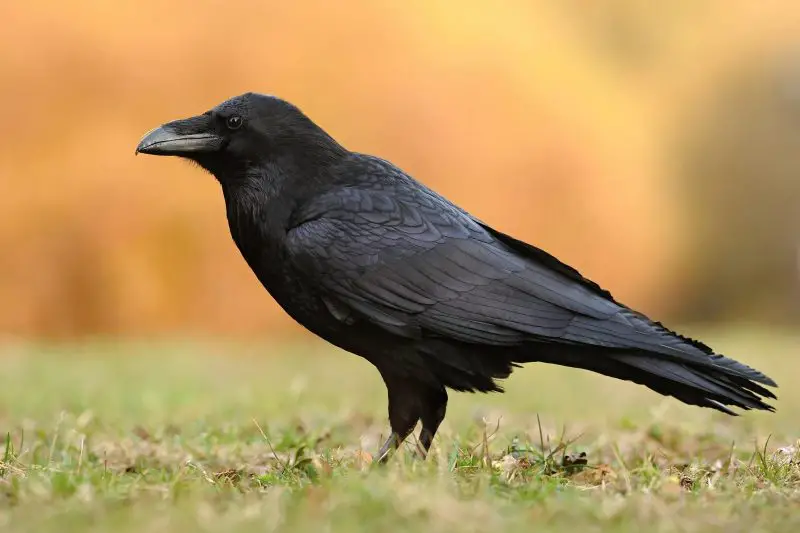
The Common Raven is the largest songbird in North America, with an imposing size and powerful flight. It measures between 22 to 27 inches in length with a wingspan of 45 to 51 inches. It has a thick, curved bill, shaggy throat feathers, and a long, wedge-shaped tail that is easily spotted in flight. The raven’s plumage is entirely black with a glossy, slightly bluish sheen.
Though not a resident bird, the Common Raven occasionally visits Indiana, particularly near the eastern and southern borders of the state. Most sightings occur in remote wooded areas, cliffs, or rugged terrain, and they are rare enough to be noteworthy. These visits are typically from wandering individuals, possibly young birds dispersing from their breeding grounds in the Appalachian Mountains or the northern Great Lakes.
Their vocalization is very different from the crow’s—deeper, more resonant, and varied. Ravens produce a range of croaks, knocks, and bell-like tones. Their signature call is a deep “gronk-gronk” or “rrrok-rrrok,” often echoing through canyons and valleys. Their calls carry far and are often used to communicate with mates or establish territory.
Common Ravens are omnivorous and opportunistic. They eat carrion, small mammals, birds, insects, berries, and human scraps. Highly intelligent, ravens have been observed using tools, playing games, and solving complex problems. While not commonly seen in Indiana, their presence suggests shifts in distribution and offers an exciting opportunity for birders in the state.
Black-billed Magpie (Pica hudsonia)
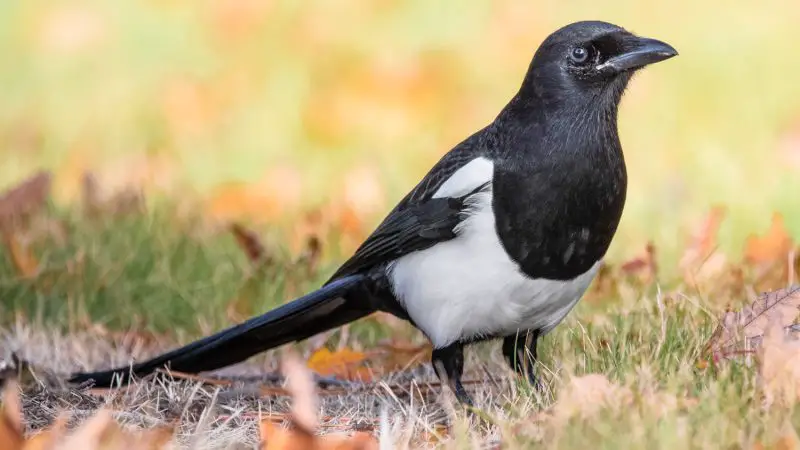
The Black-billed Magpie is a striking bird with a unique combination of bold black-and-white plumage and shimmering iridescent blue-green on its wings and tail. It measures about 17 to 24 inches in length, with its long tail making up nearly half of that. The bird’s black head, chest, and back contrast sharply with its white belly and shoulder patches, giving it a flashy and unmistakable appearance.
This species is not native to Indiana, and any sightings within the state are considered accidental or rare. Black-billed Magpies are primarily found in the open landscapes of the western United States and Canada. However, strong winds, storms, or disorientation during migration can cause individual birds to stray far from their normal range, occasionally turning up in Indiana fields, especially during late fall or early spring.
Black-billed Magpies are intelligent and inquisitive, often observed walking or hopping along the ground as they search for food. Their diet is varied and includes insects, small mammals, grains, carrion, and even food scraps. They are also known to follow large animals or vehicles to pick up disturbed insects or roadkill. Their behavior is bold and social, and they are rarely shy around humans.
These magpies are very vocal, using a variety of harsh chatter and loud squawks to communicate with each other. Their presence in Indiana is always of interest to birders, who recognize it as an unusual and special occurrence. While they are not expected to establish breeding populations in the state, occasional vagrants provide a glimpse of this charismatic western species.
Blue Jay (Cyanocitta cristata)
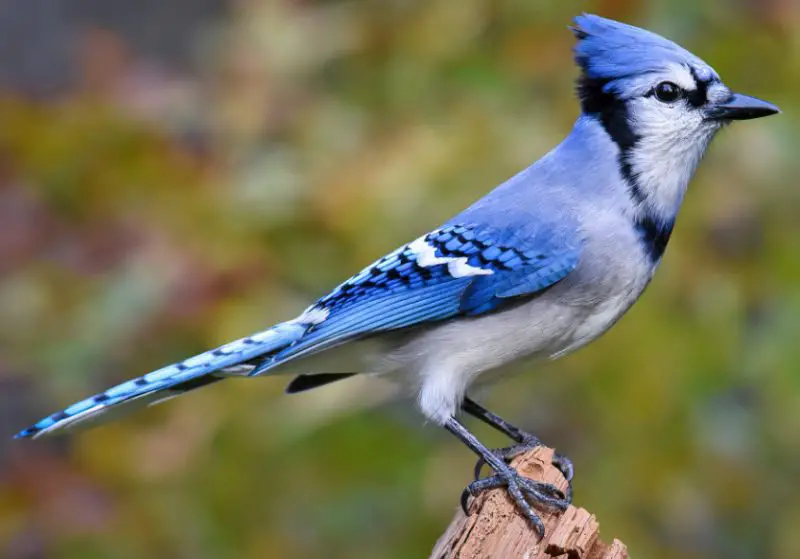
The Blue Jay is one of the most colorful and recognizable members of the corvid family in Indiana. Measuring about 9 to 12 inches in length, this bird features vivid blue upperparts, a white chest, and a distinct black “necklace” across its throat. Its crest can be raised or lowered and is often displayed during communication. The wings and tail are patterned with black, white, and bright blue.
Blue Jays are a common sight across Indiana throughout the year. They inhabit a range of environments including deciduous and mixed woodlands, suburban yards, city parks, and forest edges. These birds are well-adapted to human-altered landscapes and are frequently seen visiting backyard feeders, particularly when sunflower seeds or peanuts are available.
They are known for their noisy “jay-jay” calls, but their vocal range is extensive, including musical whistles, clicks, and harsh screams. Remarkably, Blue Jays can mimic the calls of hawks such as the Red-shouldered or Red-tailed Hawk. This behavior may serve to deceive other birds or warn fellow jays of predators. They also display complex social behavior, particularly during nesting season when they defend territories fiercely.
Blue Jays have a diverse diet that includes acorns, insects, fruits, seeds, and occasionally small vertebrates or bird eggs. They are famous for caching acorns in the fall, contributing to oak forest regeneration. Their intelligence, memory, and adaptability make them successful residents of Indiana’s varied landscapes.
European Starling (Sturnus vulgaris)
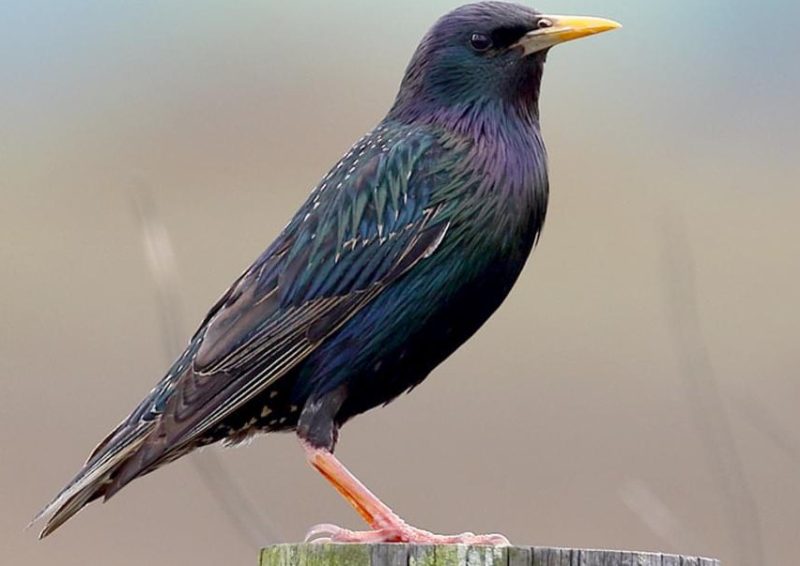
The European Starling is a medium-sized songbird with a short tail, pointed wings, and a slightly iridescent black plumage that shines with green and purple hues in good light. Adult starlings in breeding season have yellow bills, while juveniles are more uniformly dark and may be mistaken for young crows. They are smaller than crows, measuring 7.5 to 9 inches in length, and have a more compact, stocky appearance.
Starlings were introduced to North America from Europe in the 1890s and have since become one of the most abundant and widespread birds in Indiana. They are found in virtually all habitats across the state, from cities and suburbs to farms and open countryside. In winter, they form massive, swirling flocks called murmurations, often mixing with blackbirds and grackles.
Their vocalizations are varied and complex, including whistles, clicks, and buzzes. European Starlings are excellent mimics and often imitate the calls of other bird species, machinery, or even human speech. Their songs are a jumble of tones delivered with surprising fluidity and volume, especially during the breeding season when males sing to attract mates.
These birds are omnivorous and opportunistic. Their diet includes insects, seeds, grains, fruits, and food waste. They forage on the ground in groups and are often seen probing lawns and fields. Starlings aggressively compete with native birds for nesting cavities and are known to displace species like bluebirds and woodpeckers, making them a controversial presence despite their widespread success.
Clark’s Nutcracker (Nucifraga columbiana)
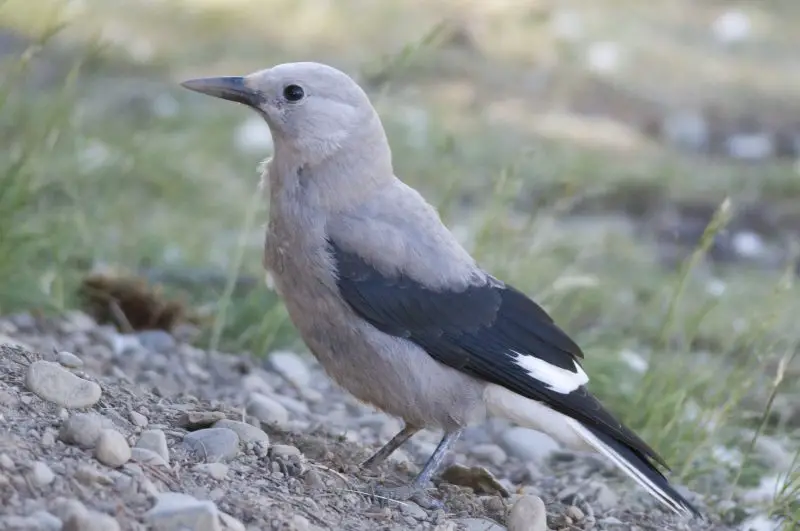
Clark’s Nutcracker is a pale gray corvid with black wings, tail, and a sharply pointed black bill. Its wings flash white patches in flight, and it has white outer tail feathers. It measures about 10 to 12 inches long, with a wingspan of 18 to 20 inches. Despite its resemblance to a jay or crow, it is easily recognized by its lighter coloration and unique behavior.
This species is native to the mountainous regions of the western United States, especially the Rocky Mountains, where it lives at high elevations among pine forests. In Indiana, Clark’s Nutcracker is considered an extremely rare vagrant. Rare sightings occur when birds wander far east of their normal range, typically due to disorientation or food shortages in their native coniferous habitats.
Clark’s Nutcrackers are known for their specialized diet of pine seeds, particularly from whitebark and limber pines. They use their strong bills to extract seeds from cones and cache them in the ground for later consumption. This caching behavior helps reforest pine areas, making them an important ecological player in the West. If seen in Indiana, the bird may shift its diet to include nuts, insects, or other available foods.
Their call is a loud, raspy “kraaaah” or “raak,” which is often repeated and carries well through the mountain air. In Indiana, hearing this call would be as surprising as seeing the bird itself. A sighting of Clark’s Nutcracker in the state is considered highly noteworthy and may attract birders from surrounding areas hoping to glimpse this out-of-place mountain specialist.
Gray Jay (Perisoreus canadensis)
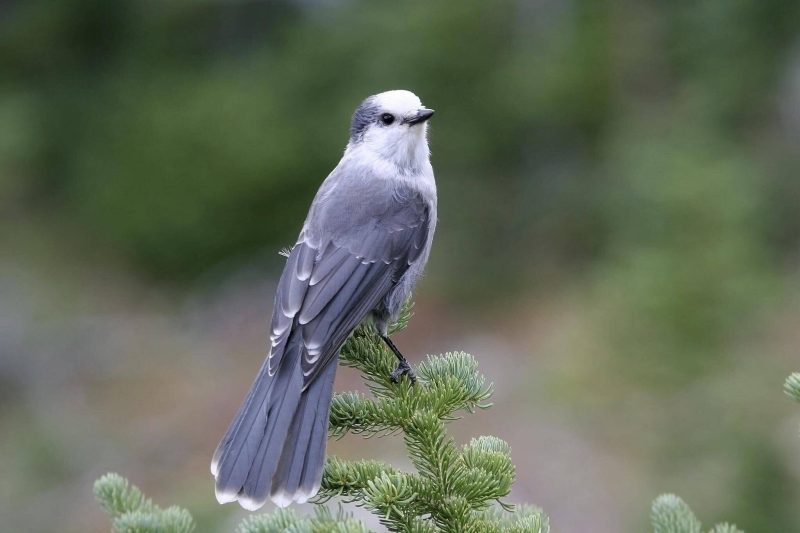
The Gray Jay, also known as the Canada Jay, is a soft-plumaged bird with a rounded head, short bill, and fluffy appearance. Adults have a pale gray body, white forehead and throat, and darker gray or charcoal crown and nape. They measure about 9.5 to 11.5 inches in length and have a quiet, gentle demeanor. The Gray Jay is built for cold climates and appears almost cuddly due to its thick feathering.
This species is a year-round resident of boreal and subalpine forests in Canada and the northern U.S., preferring spruce and fir woodlands. It is very rarely reported in Indiana, typically only during irruptive years when individuals move unusually far south, possibly in response to harsh winters or food scarcity in their usual range near the Great Lakes.
Gray Jays are omnivorous and known for storing food in tree crevices using sticky saliva. They feed on berries, insects, carrion, fungi, and occasionally human-provided foods. Their boldness and curiosity have earned them nicknames like “camp robber,” as they are known to approach campsites and take food. In Indiana, such behavior would be remarkable to witness due to their rarity in the region.
Their call is soft and varied, often described as gentle whistles, murmurs, or chattering. They lack the harsh vocalizations typical of many other corvids. A Gray Jay’s appearance in Indiana would be an exceptional record, likely drawing birdwatchers eager to see this elusive northern species outside its expected range.
Best Time and Places to See Crows and Magpies in Indiana
The best time to observe crows and magpies in Indiana is during the fall and winter months, especially from October through February. During this period, American Crows and Fish Crows often gather in large communal roosts, making them easier to locate and observe. These gatherings can be seen in both urban and rural areas, often near woodlands, river valleys, or city outskirts where trees offer shelter.
Early morning and late afternoon are ideal times to watch crows as they leave or return to their roosts. Cities like Indianapolis, Bloomington, and Fort Wayne often host large crow flocks, particularly in parks, cemeteries, and college campuses. Rural areas with open farmland and scattered trees also provide excellent viewing opportunities.
Magpies and other rare corvids like the Gray Jay or Clark’s Nutcracker are best spotted during irruption years or after strong storm events that push them out of their usual range. These sightings are extremely rare but may occur in central and southern Indiana. Birdwatching reports and local rare bird alerts can help track these unusual appearances.

